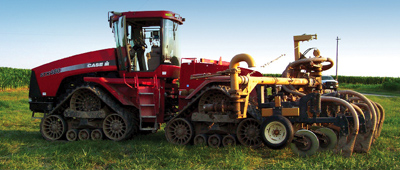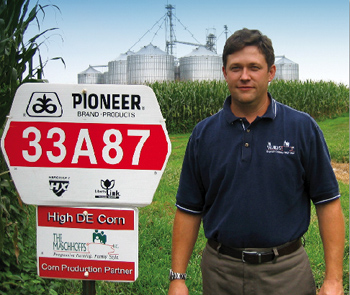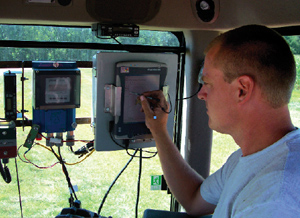
The Maschhoffs Inc, one of the
largest independent family-owned hog operations in the US, finds that
taking a systems oriented approach towards manure management—which
includes doing their own manure application—achieves the best results.
The Maschhoffs Inc, one of the largest independent family-owned hog operations in the US, finds that taking a systems oriented approach towards manure management—which includes doing their own manure application—achieves the best results.
While some large hog producers have opted for the custom applicator route for manure application, The Maschhoffs Inc, based in Carlyle, Illinois, are bucking that trend, and recently set up their own company manure application program.
The Maschhoffs takes a systems oriented approach that involves managing animal nutrition and pit microbiology, understanding the nutrient content of the manure and applying it properly, with the goal of achieving the best results.
 Their toolbars are equipped with Krohne flow meters that are coupled to on-board computers equipped with FarmWorks software. The tractors are also equipped with GPS equipment. Their toolbars are equipped with Krohne flow meters that are coupled to on-board computers equipped with FarmWorks software. The tractors are also equipped with GPS equipment. |
Having their own application setup is paying off in having more control over the details of manure application, including the timeliness of the application itself.
“It’s a bit different approach from what some other companies are doing,” says Tim Laatsch, environmental systems manager for The Maschhoffs Inc, on the decision to go with company operated application equipment for their corporate-owned operations. “But for us, it’s manageable because we aren’t dealing with a large number of company-managed farms.”
The bulk of their finishing is done with contract operations. They have more than 220 contract hog operations, that they call their “production partners.” But The Maschhoffs, one of the largest, independent family-owned swine production operations in the US, has 40 company hog operations, and manage more than 50,000 sows themselves. There are company-operated hog operations in Illinois, Oklahoma and Missouri, with most of the operations in southern and west central Illinois.
“With third-party custom applicators, we don’t have the same level of control,” says Laatsch. Quite naturally, more of the control lies in the hands of the people who own the equipment—in that case, the custom applicators.
Having full control of their own equipment brings advantages. “To take an example, we could pull on to a site with our own equipment, and it turns out we’re going to get a bunch of rain and be down for a week. In that situation, we can pull up and go to another one of our sites and take care of business there.
“We have complete control over logistics and timing, and it’s just made a huge difference in terms of getting the work done when the ground is suitable. And it goes back to cultivating the relationships we have with the crop growers, and keeping the customer happy.”
In the big picture, the company’s management practices and Laatsch’s tasks involve focusing on responsible, effective and progressive environmental management. This includes management strategies to reduce odor, protect water resources and enrich the land, including proper nutrient management.
In terms of executing that last point, Laatsch says that they carefully select the employees on their two two-man crews. He notes that while manure pumping and application may not appear complicated, the job is technically demanding and you need good decision makers to do a good job.
“The people we have doing the application work all have hog backgrounds, so they understand the production side, and the agronomic side. You can buy the best equipment in the world, but if you don’t have the right people operating it, you’re not going to get good results.” One of the crew members operates the tractor, while the other checks on the pumps and the lines.
Employee training is a high priority at The Maschhoffs. All of the crew members are certified livestock managers, and each is certified to Level Two in the multi-state voluntary manure applicators program operating in Illinois, Wisconsin and Michigan.
The Maschhoffs are expecting to soon be the first pumping business in Illinois certified to Level Three in the program. The requirements for Level Three include having written and implemented an environmental management system (EMS) for the pumping/application operation, setting equipment calibration standards and land application procedures, and having written protocols for emergency response.
 Tim Laatsch, environmental systems manager for The Maschhoffs, with a manured corn field. The company has partnered with Pioneer Hi-Bred to identify corn varieties with high digestable energy that yield well in manured cropping systems. They then offer premiums to local growers to contract deliver the preferred hybrids for milling into feed. Tim Laatsch, environmental systems manager for The Maschhoffs, with a manured corn field. The company has partnered with Pioneer Hi-Bred to identify corn varieties with high digestable energy that yield well in manured cropping systems. They then offer premiums to local growers to contract deliver the preferred hybrids for milling into feed. |
“We really place a lot of emphasis on training and education,” says Laatsch, who has a bachelor’s degree in plant and soil science from Southern Illinois University at Carbondale and a master’s degree in crop and soil science from Michigan State University.
“The objective is to be Best in Class—it’s as simple as that. We are trying to be the best manure application company, even though we are focused on company-owned sites at this point. We feel that if we build our reputation, we might be able to grow that aspect of the business.”
The manure application crews receive good direction from the home office; their work and moves are carefully mobilized from the get-go to achieve maximum efficiency. “We’ve got our application plans/target fields all laid out heading into the harvest period, so as soon as the first corn comes off, we’re moving in and are ready to start work,” explains Laatsch.
Carrying out that work in the office, and in the field, is a team of three agronomists who have the unenviable task of keeping track of regulations in the states in which they operate. Last year, The Maschhoffs purchased all of Land O’Lakes’ swine production assets. The transaction involved approximately 60,000 sows and contract production facilities in Oklahoma, Missouri, Iowa and Illinois.
“So in the last year, we have been working to sort out the regulations in the additional states, plus setting up the agronomic guidelines, getting the crop nutrient uptake rates and coupling that to manure analysis so we get the right application rates on the ground.”
While those agronomists are spending a fair bit of time planning, they are also out on the farms, making sure there’s a good fit between what’s being planned in the office, and what actually works in the field.
“We believe in coupling agronomists and people with farm backgrounds into this process,” says Laatsch. “With our manure application, we are working with a large number of row crop specialists on neighboring farms. And they are very much tuned into the bottom line, just like we are in the hog business. They expect us to properly manage the manure fertilizer product that we are delivering to them.”
The data that is developed from the field and in the office is plugged into a sophisticated internal information system. The company has invested heavily in the development of a proprietary SQL-based database system known as MEDS—for Maschhoffs Environmental Data System. Their next step is to embed ArcMap GIS directly into the SQL system, Laatsch explains.
“We basically have the equivalent of one-button state reporting for Illinois and are just a couple of steps away from having the same capabilities in Iowa.
“With MEDS, it’s not pushing one button to get all the data in,” Laatsch explains. “There’s a tremendous amount of background data and planning work that has to be done in the programming interface. But when we get to the end, we have the ability to hit a button and basically generate a single electronic PDF document several hundred pages in length, that is indexed and sequentially numbered, that can be sent to the state or the USDA, and satisfy state regulatory requirements and USDA requirements under the EQIP program.”
While it has a well-developed manure management and application program for its own company operations, The Maschhoffs also work with the more than 220 contract hog operations, their “production partners.” They have stepped up the environmental services they are offering to contract producers in the last year, and have written a large number of plans for producers that fall under the USDA EQIP program.
 Mike Kampwerth, environmental operations manager for The Maschhoffs, in one of the tractor cabs. Mike Kampwerth, environmental operations manager for The Maschhoffs, in one of the tractor cabs. |
“We are just getting the ball rolling in Iowa, but we have a similar environmental services type vision there as we have in Illinois—we want to offer high quality service at the best possible value and get as many contract growers under our umbrella of services.
“We’re not all about control, but we feel there tends to be a little bit of a gap in the market in the environmental services area, and we feel we’re filling a need for our producers in terms of regulatory compliance.”
The approach to offering these services, and the benefits, are often pretty straightforward. “We can show producers that it brings tremendous value to their farm. We can document and demonstrate that if you are using the manure resource effectively, there can be a tremendous bottom line impact.” One of the main messages: there is money to be made by effectively managing your manure. “It might take only five minutes to walk one of our contract people through an example, and show them how they can put an extra five, eight or ten thousand dollars in their pocket every year.
“It can still be a challenge because we are dealing with a lot of different people who have different ideas in the grower community. But at this point, I would say the vast majority of producers understand the value in having a professional person dedicated to tracking these regulations. They don’t need to know all the details—we can provide that for them and get them where they need to be.
“I think what drives a lot of the contract people to work with us is that the complexity of the regulations can be almost overwhelming. The landscape is dynamic and the regulations are constantly changing. And most of these guys just want to raise pigs—they don’t want to be specialists in government regulations.”
The potential value of manure—notwithstanding the higher level of interest in using manure because of higher commercial fertilizer prices—has been there for a long time, and in some cases, has been kind of dormant, says Laatsch. What needs to be done, he says, is to translate that potential into realized value. “And that’s almost entirely a function of managing the manure.”
The company is rolling out a new initiative for its contract partners this year. They are going to carry out environmental assessments on contract operations, and provide a financial incentive for the partners—in the form of subsidized environmental services from the company—to address any gaps in the farms’ performances.
In terms of performance on the company side, The Maschhoffs take a very systematic approach. They carry out manure sampling from each barn annually, at the same time of year, using the same lab, to achieve consistent results. “The results help to optimize the realized value for the row crop partners that we deal with.”
The company has partnered with Pioneer Hi-Bred to identify corn varieties with high digestible energy that yield well in manured cropping systems. They then offer premiums to local growers to contract deliver the preferred hybrids for milling into feed.
They have also partnered with United Feeds and use that company’s OptiPhos phytase enzyme additive to better manage phosphorus levels. “We believe pretty firmly, and we have already implemented this strategy system-wide, that we can reduce phosphorus tremendously if we focus on managing the feed for the nutritional requirements of the animal.”
All of this is going to become more important with pending CAFO regulations and increasing regulations governing phosphorus levels. “That’s why we feel our systems level approach—managing animal nutrition, managing pit microbiology, understanding manure, the nutrient content of the manure and applying it properly—gets the best results.”
| Two-man crews handle manure application
The Maschhoffs Inc made the move to using their own manure application equipment in 2005, setting up two two-man crews which now handle all of the manure application on the company-owned hog operations. They use Cornell 4NHTB pumps powered by 855 Cummins engines. The units are mounted on 26-foot gooseneck trailers along with a 500-gallon fuel tank that supplies fuel to other tractors on site. The trailers also carry their four wheelers and hose fittings. They use six-inch military surplus feeder hose, with each crew having two miles of hose. Their draglines are five-inch Snap-Tite and each crew has two sections 660 feet long. The Dietrich shanks are spaced at 24 inches. “The 24-inch spacing does a better job of evenly spreading nutrients and cuts down on streaking,” says Mike Kampwerth, environmental operations manager for The Maschhoffs. “We believe we’ve invested in equipment that sets us apart from other custom applicators,” adds Kampwerth. One capability they have, which they believe sets them apart at least in Illinois, is radio frequency controls in all the tractor cabs and on the hand-held radios. This enables tractor operators or the guys running the line to shut down the pump, or even idle it down so they can shut the gate valve on the end, stopping the flow of manure when the toolbar is not in the ground. The tractors are equipped with GPS equipment. “We map everything we do,” explains Kampwerth. “We use GPS application mapping and use the GPS system for guidance and layout, and real-time setback compliance.” Each crew has a CaseIH STX 480 Quadtrac for plowing and a CaseIH MX 275 MFD for pulling the hose reel and agitating. These tractors also are used for their grain farm operation. They also have backhoes on standby, two Case 580 SuperK machines. Most of the applications are done out of deep pit buildings. Some tanker work is done, and they have two semi-tankers for those jobs.
|